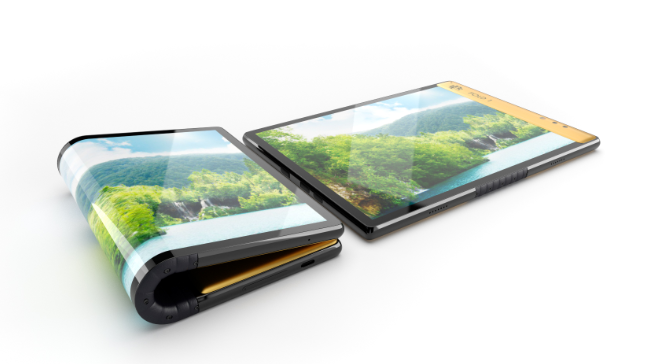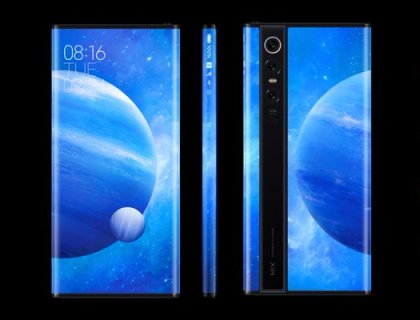Most insane smartphone innovations that will go mainstream in 2020
Smartphone makers, this year, showcased awesome futuristic concept smartphones with cutting-edge technologies and features, taking smartphone experience to a whole new level.

With the ever-increasing competition and advances in emerging technologies such as 5G, Artificial Intelligence, Virtual Reality, smartphone makers are continuously pursuing exceptional innovation to gain the consumer's attention and drive their market shares.
From foldable form factor to 5G-enabled phones, all-screen design to surround (all-round) display to fast-charging flagships, 2019 was indeed a year of smartphone breakthroughs.
As we approach the end of 2019, its time to do a quick recap of the most insane and nascent smartphone technologies that will become mainstream in 2020.
-
Foldable phones
With the launch of its first foldable phone-cum-tablet, the Galaxy Fold, South Korean technology giant Samsung opened a new frontier in the smartphone industry. The Samsung Galaxy Fold arrived with a high-end large display, powerful processor, dual-battery and, notably, an eye-watering price tag of USD 1,980.
Following in the footsteps of Samsung, Huawei launched its first-ever foldable smartphone dubbed the Mate X featuring an outward-folding design and Leica Quad Camera System. Motorola, too, joined the foldable phone race with the 2019 edition of its Moto Razr with average specifications and entirely different form factor as compared to the former two devices.

Then came the Escobar Fold 1, the most affordable Android foldable phone with top-of-the-line specs and features available in the market so far. Priced starting at USD 349 (approx. Rs 25,000), the device emerged as a cheap alternative to the highly expensive Galaxy Fold and Huawei Mate X, turning the race more fierce.
Other bigwigs like Xiaomi, Microsoft, Oppo are gearing up to announce their offerings in 2020.
-
Innovative displays
Chinese electronics company Xiaomi unveiled the Mi Mix Alpha, a 5G concept smartphone with the world's first Surround (all-round) Display with a screen-to-body ratio of more than 180.6 percent.

The Xiaomi Mi Mix Alpha has minimal bezels on the top and bottom (2.15mm), Driver IC for display on both sides, pressure-sensitive edges coupled with a linear motor that simulates the touch of physical buttons and a brand-new display acoustic technology to replace the traditional earpiece receiver and proximity sensor. The top and bottom metal frames are built with aerospace-grade titanium alloy while the camera strip is made up of sapphire glass embedded in high-precision ceramics.
Consumers also saw premium flagships like the Vivo NEX 3 with bezel-less and notch-free Waterfall FullView Display and a 99.6 percent screen-to-body ratio. Ditching the physical volume and power buttons, the NEX 3 responds to every touch with tactile feedback using the Touch Sense system that works in conjunction with the X-axis tactile response mechanism.
-
All-screen phones
Smartphone makers, this year, showcased awesome futuristic concept smartphones with cutting-edge technologies and features, taking smartphone experience to a whole new level. One of them was Vivo's APEX 2019, a 5G concept smartphone with several breakthrough features. The exceptional smartphone has no openings, physical buttons or bezels.

Instead of USB ports, the device adopts MagPort, a magnetic power connector that enables both charging and data transfer while the physical buttons are replaced by Touch Sense technology. The ambitious device features Full-Display Fingerprint Scanning technology that allows users to touch almost anywhere on the screen to unlock the device seamlessly.
All-screen phones with no notches, no holes became more prevalent. Mid-rangers such as Redmi K20, Oppo Reno 2Z, OnePlus 7 Pro paved the way for nearly full-screen smartphones. On the other hand, Samsung introduced an innovative triple-lens rotating camera for a bezel-less and notch-less display. The triple camera on the Galaxy A80 slides and rotates to capture the front and rear views as well.
-
Under-Screen Camera technology
Oppo and Xiaomi came up with yet another innovative camera technology that could be an ultimate solution for an all-screen display in future smartphones.
Do you want a sneak peek at the future? Here you go...introducing you to Under-Display Camera technology!#Xiaomi #InnovationForEveryone pic.twitter.com/d2HL6FHkh1
— Xiaomi #First108MPPentaCam (@Xiaomi) June 3, 2019
Oppo’s under-screen display (USC) solution that the company recently showcased at its annual technology convention in Shenzhen, features a customized selfie-camera module for a complete photography experience, whilst simultaneously offering a full-screen experience to users. The technology would enable users to see and capture the entire screen, take photos, use face unlock and make video calls.
-
Fast charging tech
Fast charging technology gained momentum and went mainstream in 2019. Starting with the Realme X2 Pro, it ships with a 4000mAh battery with 50W SuperVOOC Flash Charge capability that charges the phone completely in 35 minutes.
Oppo took bigger strides with 65W SuperVOOC 2.0 Flash Charge, the Chinese phone maker's proprietary flash charging solution. Touted as the most advanced commercialized charging solution to date, the fast charging solution carries Oppo Reno Ace's 4000mAh battery from 0 to 100 percent in just 30 minutes.
The competition is expected to become even more intense in the upcoming year. Xiaomi's 100W Super Charge Turbo technology that the company claims can fully charge a 4000mAh battery in just 17 minutes will become mainstream in 2020.
And to take on Xiaomi, Vivo has already announced the industry-leading 120W Super Flash fast-charging technology. As per the data from the lab test, the fast charging solution takes only 5 minutes to charge a 4,000mAh battery from 0 to 50 percent, and 100 percent in just 13 minutes.
-
Multiple camera lenses
Smartphone makers, especially those from China, have reignited the so-called megapixel war to woo consumers. From 48-megapixel to 64-megapixel and now 108-megapixel image sensors, major smartphone vendors including Xiaomi, Realme, Vivo launched high-resolution camera phones at affordable price tags.
Along with the sensor size, consumers also witnessed a major leap in the number of lenses in smartphones, going as high as five sensors on the rear module and two on the front panel. Not only high-end phones but budget phones have also added multiple camera modules that include a dedicated telephoto lens, ultra-wide or wide-angle lens to enhance smartphone photography which is a must-have feature today.

From the quad-camera module on the Realme X2 Pro to the Penta-lens arrangement on the Nokia 9 PureView, OEMs left no stone unturned to impress consumers. A recent example is the Xiaomi Mi Note 10, aka the Mi CC9 Pro in China. The premium flagship device comes with the world's first 108MP Penta camera setup with up to 50x digital zoom capability. The setup includes a primary lens, a telephoto lens, a portrait lens, an ultra-wide-angle lens, and a macro lens.
(Disclaimer: The opinions expressed are the personal views of the author. The facts and opinions appearing in the article do not reflect the views of Devdiscourse and Devdiscourse does not claim any responsibility for the same.)
- FIRST PUBLISHED IN:
- Devdiscourse










